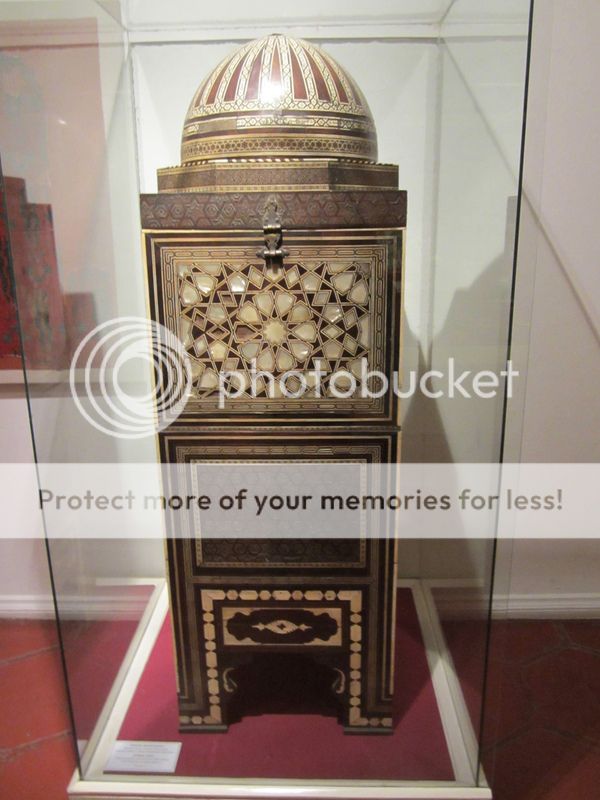GPS : 41°00'22.1"N 28°58'29.7"E / 41.006126, 28.974911

PHOTOGRAPHS ALBUM
The Museum of Turkish and Islamic Works and Arts has a collection consisting of authentic items reflecting the lifestyle and culture of the Turkish people. The museum consists of seven sections: Wooden Works, Ceramics and Glass, the Metal Art, Ethnography, Stone Art, Carpet and Hand Writing and Calligraphy Section.
The collection includes notable examples of Islamic calligraphy, tiles, and rugs as well as ethnographic displays on various cultures in Turkey, particularly nomad groups. These displays recreate rooms or dwellings from different time periods and regions. The rich carpet collection of the museum is unprecedented showcased together with other rare items from around the world. Its collection of roughly 15,000 manuscripts (spanning through the 8th-19th centuries) introduce its visitors to a historical adventure of the development of a basic civilization.
The Museum of Turkish and Islamic Works and Arts is a cultural place showing how to masterfully bring together the core culture of a nation with a great civilization. After having been honoured with Islam, Turks played a leading role in the development of the Muslim civilization, its cultural richness, and social life. The museum provides an ethnographically rich detail for its visitors with its objects made of stone, ceramic, wooden and metal as well as black tents and yurts which were the essential components of the nomadic Turks’ daily lives.
The main collections on the upper level include rare and beautiful works from all periods of the Turkish and Islamic world, including objects from the Ummayid, Abbasid, Mamluk, Seljuk, Beylik and Ottoman periods, ranging in date from the seventh century to the nineteenth. The collections include carpets, manuscripts and calligraphy, miniatures, woodwork, ceramics and glassware, metalwork and folk-arts, altogether an extraordinary exhibit, superbly displayed.
The ethnographical collection consists principally of objects belonging to the Yürük, the nomadic Turkish people of Anatolia, whose way of life has not changed in its essentials since the first Turcoman tribes made their way into Asia Minor after the battle of Manzikert in 1071. The most fascinating exhibits here are the black goat-hair tents of the Yürük, furnished with objects that these nomads still use in their daily life, a living heritage of Anatolian Turkish culture.
The Anatolian woodworks belong to the 9th and 10th centuries as do the works during the Anatolian Seljuk and Beylik period. The woodworks of tortoiseshells inlaid with ivory and mother-of-pearl belong to the Ottoman period and are under exhibit in the Section of Wooden Works.
In the Section of Ceramics and Glass, visiters can see examples of 10th century Islamic glass art samples, ceramic works discovered during excavation works between the years of 1908 and 1914, mihrab and wall encaustic tile samples, and plaster ornaments of the Konya Kılıçaslan Palace.
In the Metal Art Section, visitors are able to view the door knockers from the Cizre Ulu Mosque, constellation and planet symbols, spouted ewer, and dirhems constitute.
Ethnographic pieces, which have been collected over a long period of time are on exhibit in the Etnography Section. Among the works exhibited in this section are nomadic society’s daily life tools and equipment, costumes, kilim looms, and materials giving information about the art of carpet weaving. In the other sections of the museum, there are also many qualified works of art, science, art, and culture that shed light on Turkish-Islamic culture which have managed to become inseparable parts of the visual composition of the culture.
Of the museums of Istanbul, this one holds a great interest to the domestic and foreign tourists, researchers, students, and art-lovers who it welcomes. Within the walls of the Museum of Turkish and Islamic Works and Arts lies a treasure of culture which was sophisticatedly developed in the past and which has been carried into future.
Turkish and Islamic Works Museum has been awarded with the Special Jury Award of Museum of the Year Competition of the European Council in 1984 and with the prize given by European Council - Unesco for its studies for making the children love the culture inheritance. Turkish and Islamic Works Museum, that is among the important museums of the world in its class has works from almost all periods and all types of Islamic art with its collection exceeding forty thousand works.
LOCATION SATELLITE MAP
WEB SITE : Turkish and Islamic Arts Museum
MORE INFO & CONTACT
E-Mail : tiem@tiem.gov.tr
Phone : +90 212 518 1805
Fax : +90 212 518 1807
These scripts and photographs are registered under © Copyright 2017, respected writers and photographers from the internet. All Rights Reserved.
No comments:
Post a Comment